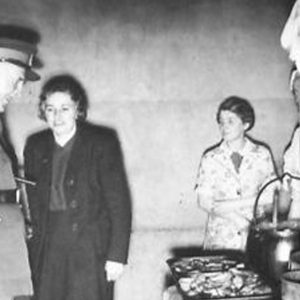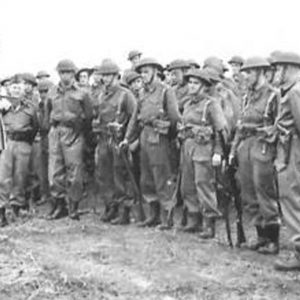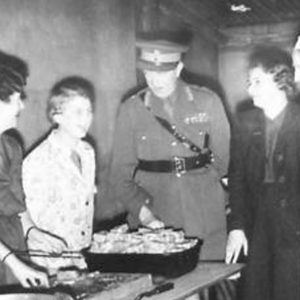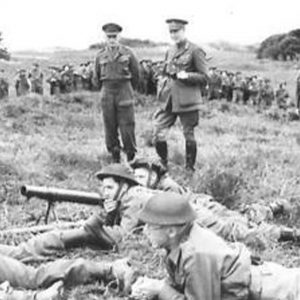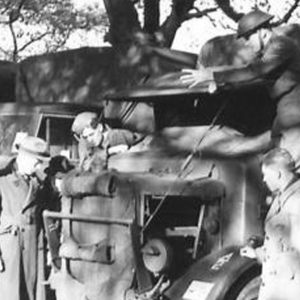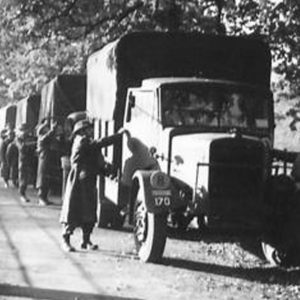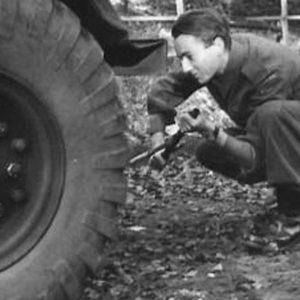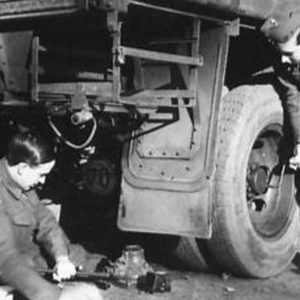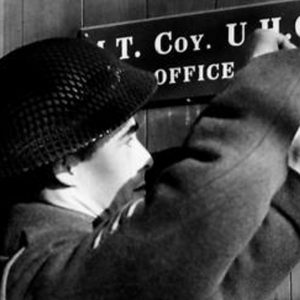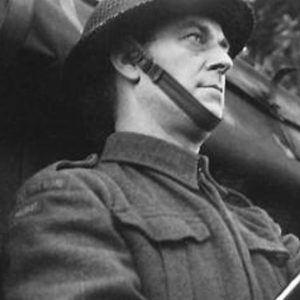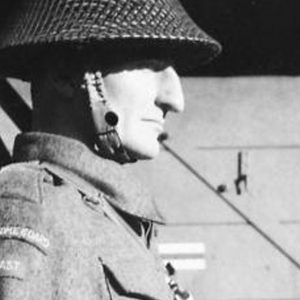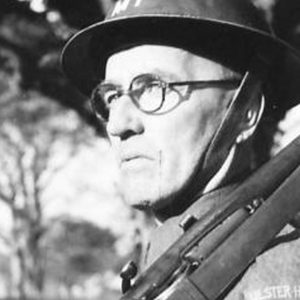Throughout the Second World War, tens of thousands of men served in the Home Guard across the United Kingdom. First formed as the Local Defence Volunteers in the wake of the Dunkirk Evacuation, the organisation became the Home Guard in 1942. In Northern Ireland, the Ulster Home Guard operated a little differently to their counterparts in Great Britain.
The Local Defence Volunteers and Home Guard existed to support the British Army in the case of an enemy invasion within the United Kingdom. Following the Fall of France and Dunkirk Evacuation, the British Army would need the assistance of these volunteers.

Imperial War Museum Photo: H 25074 (Part of the War Office Second World War Official Collection). Personnel of a Home Guard Motor Transport Company in Ulster pictured in an army lorry. Members of this company did some of their training with the Royal Army Service Corps in Northern Ireland. Photo taken by Lieutenant Bainbridge - War Office Official Photographer.
In Northern Ireland, fears of an enemy invasion ran high. Operation Sea Lion was the codename given to German plans to invade the United Kingdom. Within that plan, Operation Green was the intention of also invading Ireland. In the north, there was talk of a Nazi invasion either by air with troops parachuting in around Lough Neagh to take the Co. Antrim airfields, or by land with troops crossing the border from Eire into Co. Down.
In response to the perceived threat of Operation Sea Lion, authorities in the United Kingdom established a new organisation with a focus on Home Defence. On 14th May 1940, a call went out across the British Broadcasting Corporation airwaves in 1940 for volunteers. Soon, men aged between 17 and 65 joined the ranks by volunteering for service at their local police stations… but not in Northern Ireland.
1940: Formation of the Local Defence Volunteers
In England, Scotland, and Wales, thousands of men signed up at their local police station. The Local Defence Volunteers came under the command of existing Territorial Army units and volunteers attested to military service. This meant, they swore an oath of allegiance to The Crown and became a member of the British Army. This raised issues in Northern Ireland due to political sensitivities and the fact that Ulster did not have the same Territorial Army structure. In 1940, Prime Minister Winston Churchill had no plans to extend the Local Defence Volunteers to Northern Ireland. In Belfast and throughout counties Antrim, Armagh, Down, Fermanagh, Londonderry, and Tyrone, men turned up at Royal Ulster Constabulary barracks only to be sent home disappointed. Northern Ireland’s Prime Minister Lord Craigavon successfully lobbied Churchill to extend the coverage of the Local Defence Volunteers in 1940.
Still, the issues of complexity surrounding the formation of the Local Defence Volunteers in Northern Ireland remained. Northern Ireland, was the only part of the United Kingdom not to enforce conscription during wartime. Therefore, there were not the same Territorial Army associations that formed the basis of the volunteer force in Britain. This left organisation of the LDV in Northern Ireland to the Ulster Special Constabulary, known as the B Specials.
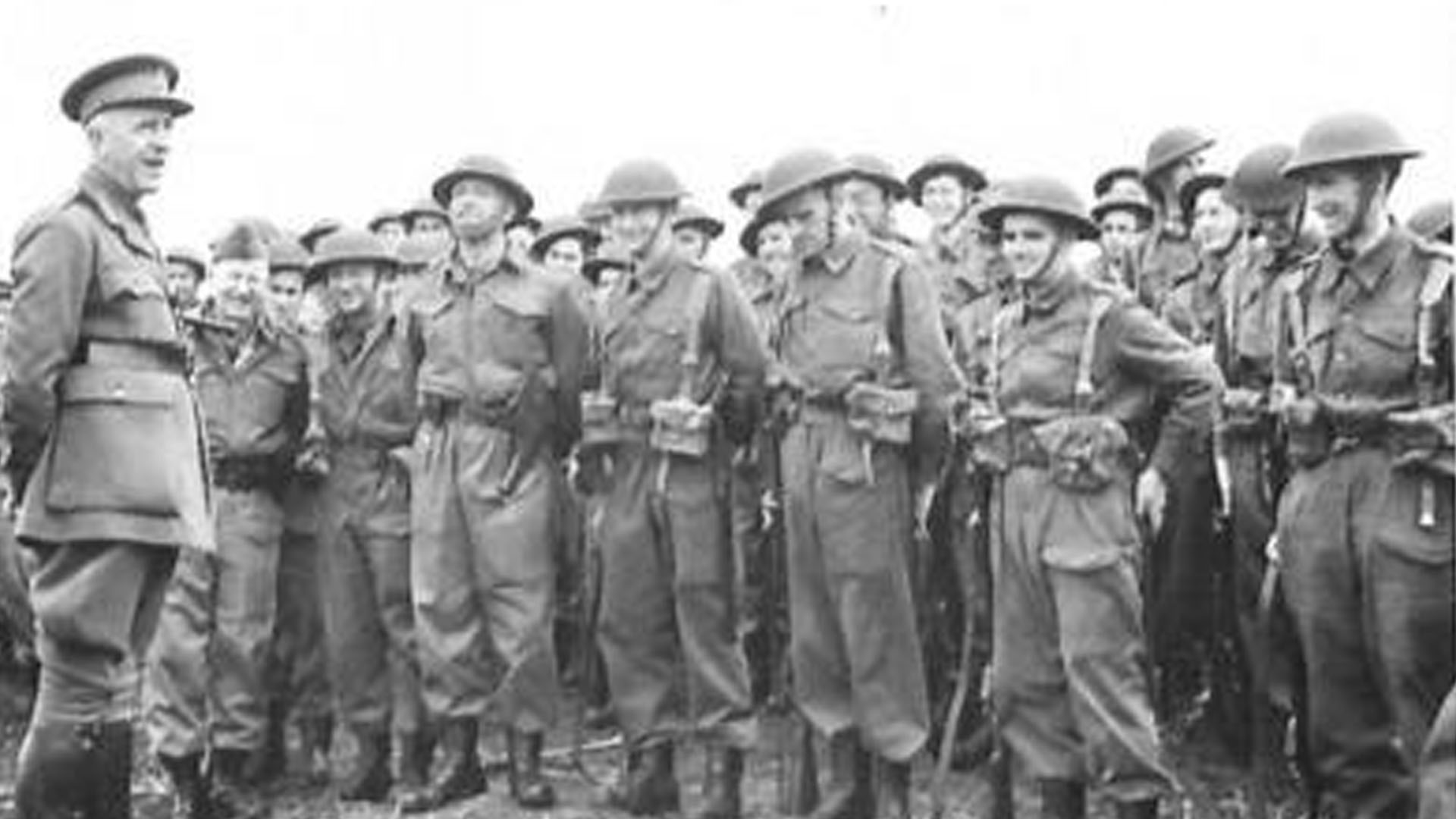
Imperial War Museum Photo: (H 30676) (Part of the War Office Second World War Official Collection). Lieutenant General Franklyn talks with the volunteers of 3rd Down Battalion, Ulster Home Guard during a training session at Murlough House, Dundrum, Co. Down on 8th June 1943. Copyright Lieutenant J.R. Bainbridge - War Office Photographer.
For historical and political reasons, Nationalist newspapers complained that any force organised by the B Specials could not command cross-community support. This was evidenced by the fears of Lord Craigavon and Minister of Public Security John MacDermott. Their concern was that British Army weaponry would end up in the hands of Nationalist or Republican paramilutary organisations such as the Irish Republican Army.
It is most important that the Army should not become involved in political differences. At the same time it is equally important that weapons should not get into the hands of undesirable elements, and that the latter should not get a foothold in our military machine. It is difficult for the Army to differentiate. At present it is best done for them by the Constabulary on the best information.
In 2015, Home Guard veteran John Luke spoke to the BBC for a documentary ‘Not Dad’s Army: Northern Ireland’s Home Guard’. He made reference to the limited support received from Catholic and Nationalist communities.
We had over 300 in our Battalion and, as far as I can remember, there were two Catholics. I’ll not say they objected, but they didn’t join. They weren’t aggressive towards us though.
In 1942, the British Government at Westminster made a request to the Northern Ireland Government at Stormont. They wished to know the number of Catholics recruited in these voluntary home defence Battalions. Of a total of almost 40,000 members, the number of Catholic volunteers was around 150, which is a figure of around 0.5%.
Being organised by a local police force had pros and cons for the Local Defence Volunteers. On the negative side, volunteers ran the risk of identifying as partisans if fighting an invading army. For this, outside of the protection of the Geneva Convention, they could be shot. volunteers in Ulster had not sworn allegiance to The Crown, and as such, were not a legitimate part of the British Armed Forces.
This led to inconsistencies between the Home Guard in Great Britain and the same force in Northern Ireland. For example, Platoon Sergeant W.B. Anderson of the Ulster Home Guard received the British Empire Medal (Civil Division). In Great Britain, those receiving medals received Military Division awards.
A solution put forward was that in the event of invasion, the volunteers would fall under command of the British Army. Some thought, the army should have control over the volunteers anyway. Others argued that the Ulster Special Constabulary were better organised and armed than the army. Of course, many in the Nationalist communities viewed the British Army as a distrusted occupying force. Secretary of State for War David Margesson spoke of the:
Absolute necessity of not involving the army in the religious animosities of Ireland.
On a more reassuring note for the organisation in Northern Ireland, was their strength of arms in 1940. The Royal Ulster Constabulary and Ulster Special Constabulary remained well-armed while much of the British Army lost valuable equipment at Dunkirk. In 1940, the Royal Ulster Constabulary was in a position to lend the British Army 300 Lewis Machine Guns.
On 28th May 1940, volunteering commenced for the Local Defence Volunteers Section, Ulster Special Constabulary or the Ulster Defence Volunteers. The initial drive brought the defences of Northern Ireland up to around 3,000 Royal Ulster Constabulary, 12,000 Ulster Special Constabulary, and 12,000 Local Defence Volunteers. By August 1940, the strength of the L.D.V. stood at 26,000.
The original Local Defence Volunteers in Ulster wore plain clothes with an armband signifying their role. Later, they adopted the uniform of the Ulster Special Constabulary, sporting the cap badge of the R.U.C. and wearing ‘L.D.V.’ armbands. The denim uniforms of the Local Defence Volunteers should have been green but a problem with the dying process rendered them black. When combined with khaki greatcoats, Nationalists were quick to point out the similarities in the uniform of The Black and Tans. This issue remained until late in April 1941, when new khaki coloured uniforms arrived.
Despite the volunteers’ organisation by the Ulster Special Constabulary, veterans of the Ulster Home Guard mostly considered themselves volunteer soldiers rather than members of the B Specials.

Imperial War Museum Photo: (H 25069) (Part of the War Office Second World War Official Collection). A Lance Corporal in an Ulster Home Guard Motor Transport Company received his work tickets from a Sergeant somewhere in Northern Ireland on 1st November 1942. Copyright Lieutenant J.R. Bainbridge - War Office Photographer.
1942: The Ulster Home Guard
In March 1942, reorganisation of the Local Defence Volunteers across Ulster took place. The organisation became the Ulster Home Guard, volunteers attested to The Crown, and became a legitimate part of the British Military.
The role of the Local Defence Volunteers and the Ulster Home Guard was one of Home Defence. In Ulster, this involved closing off beaches around the extensive coastline. Volunteers built large concrete bunkers, some of which still stand along the north coast over 80 years later. The posts, barbed wire, and mines laid in the early 1940s are now long gone.
Training of volunteers took place in all manner of settings from city streets, to rivers, mountains, and quarries. As well as regular Battalions, the Ulster Home Guard boasted 7 Heavy Anti-Aircraft Troops, a Motor Transport Company, and a Motor Boat Patrol.
Home Guard Motor Transport Company
On 1st November 1942, War Office Photographer Lieutenant Bainbridge photographed volunteers in what was was thought to be the only Home Guard Motor Transport Company in the United Kingdom. The photos were taken in Northern Ireland where the volunteers trained with the Royal Army Service Corps.
Although some referred to the L.D.V. as the “luk, duck, and vanish brigade”, the Ulster Home Guard was a capable military organisation. By 1944, their range of weaponry included .303 Lee Enfield Rifles, .45 Webley Revolvers, M.K.I. Sten Gun, No. 36 Hand Grenades, No. 38 Blast Grenades, and Anti-Tank Grenades. Among the heavier weapinry was the Spigot Mortar, capable of firing 14lb anti-personnel bombs or 20lb anti-tank bombs.
Additional training for the Ulster Home Guard took the form of mock battles fought against regiments of the British Army or the United States Army after 1942. Umpires judged the results and veterans of the Home Guard insist their local knowledge often made them the winners.
Home Guard Motor Boat Patrol
On 19th September 1942, War Office Photographer Lieutenant Bainbridge photographed volunteers an Ulster Home Guard Motor Boat Patrol on duty in Northern Ireland.
Following the Battle of Britain in the Autumn of 1940, the threat of an enemy invasion lessened and volunteers in the Ulster Home Guard took on other tasks. Among these were manning Anti-Aircraft Batteries. The role of volunteers in positions of Home Defence and at Anti-Aircraft Batteries freed up many thousands of regular soldiers to fight overseas during the Second World War. The presence of Home Guard volunteers on the streets may also have boosted reassurance among the civilian population in wartime.
Watch members of the Ulster Home Guard training in ‘Ack-Ack’ warfare on BBC Northern Ireland.
Although Northern Ireland suffered in the Belfast Blitz of April and May 1941, the feared invasion never came. Ulster men continued to volunteer for the Home Guard throughout the Second World War and by March 1944, the organisation totalled 29 Battalions and a strength of over 30,000. As the course of the Second World War swung in favour of the Allies following the Normandy Landings, disbanding of the Ulster Home Guard took place in December 1944.
Watch ‘The Story of the Ulster Home Guard’ on the Northern Ireland Screen Digital Film Archive.

Imperial War Museum Photo: (H 30674) (Part of the War Office Second World War Official Collection). Lieutenant General Franklyn talks to Lieutenant Colonel J. Bagwell, M.V.O.,M.C., Commanding Officer of 3rd Down Battalion, Ulster Home Guard at Dundrum, Co. Down on 8th June 1943. Copyright Lieutenant J.R. Bainbridge - War Office Photographer.
Belfast City
The following information comes from 'Stand Down, Orders of Battle for the Units of the Home Guard of the United Kingdom - November 1944'.
| Battalion | City/Town | Commanding Officer |
|---|---|---|
| 2nd Belfast Battalion | Belfast (East) | Lieutenant Colonel J.D. Nicholl O.B.E., M.C. |
| N Heavy Anti-Aircraft Troop, B Company, 2nd Belfast Battalion | Belfast (East) | Major J. Kerr M.B.E. |
| Q Heavy Anti-Aircraft Troop, C Company, 2nd Belfast Battalion | Belfast (East) | Major W.R. White M.C. |
| 3rd Belfast Battalion | Belfast | Lieutenant Colonel R.S. Drean M.C. |
| R Heavy Anti-Aircraft Troop, E Company, 3rd Belfast Battalion | Belfast | Major G.E. Wainwright |
| 4th Belfast Battalion | Belfast | Lieutenant Colonel J.N. Fulton O.B.E. |
| O Heavy Anti-Aircraft Troop, A Company, 4th Belfast Battalion | Belfast | Major S.P. Beggs |
| 5th Belfast Battalion | Belfast | Lieutenant Colonel The Right Honourable H.G.H. Mulholland M.P. |
| S Heavy Anti-Aircraft Troop, E Company, 5th Belfast Battalion | Belfast | Major T.J. Marshall |
Derry/Londonderry City
The following information comes from 'Stand Down, Orders of Battle for the Units of the Home Guard of the United Kingdom - November 1944'.
| Battalion | City/Town | Commanding Officer |
|---|---|---|
| 1st Londonderry Battalion | Derry/Londonderry | Lieutenant Colonel R.B.W. Irwin O.B.E., M.C. |
| 2nd Londonderry Battalion | Derry/Londonderry | Lieutenant Colonel J.I. Mclaughlin |
Co. Antrim
The following information comes from 'Stand Down, Orders of Battle for the Units of the Home Guard of the United Kingdom - November 1944'.
| Battalion | City/Town | Commanding Officer |
|---|---|---|
| 1st Antrim Battalion | Ballymoney | Lieutenant Colonel V. Unsworth M.C. |
| 2nd Antrim Battalion | Ballymena | Lieutenant Colonel A.O. Chichester O.B.E., M.C. |
| 3rd Antrim Battalion | Carrickfergus | Lieutenant Colonel J.A. McFerran |
| T Heavy Anti-Aircraft Troop, F Company, 3rd Antrim Battalion | Carrickfergus | Major A.E. Holmes |
| 4th Antrim Battalion | Antrim | Lieutenant Colonel A.C. Herdman O.B.E. |
Co. Armagh
The following information comes from 'Stand Down, Orders of Battle for the Units of the Home Guard of the United Kingdom - November 1944'.
| Battalion | City/Town | Commanding Officer |
|---|---|---|
| 1st Armagh Battalion | Lurgan | Lieutenant Colonel J. Morton |
| 2nd Armagh Battalion | Portadown | Lieutenant Colonel A. Walls |
| 3rd Armagh Battalion | Bessbrook | Lieutenant Colonel H.A. Whiteside |
| 4th Armagh Battalion | Armagh | Lieutenant Colonel R.J. Tamplin D.S.O. |
Co. Down
The following information comes from 'Stand Down, Orders of Battle for the Units of the Home Guard of the United Kingdom - November 1944'.
| Battalion | City/Town | Commanding Officer |
|---|---|---|
| 1st Down Battalion | Newtownards | Lieutenant Colonel J. Bagwell M.V.O., M.C. |
| P Heavy Anti-Aircraft Troop, D Company, 1st Down Battalion | Newtownards | Major A.E. McConnell |
| 2nd Down Battalion | Downpatrick | Lieutenant Colonel J.A. Jaye |
| 3rd Down Battalion | Newry | Lieutenant Colonel A. Turkington |
| 4th Down Battalion | Banbridge | Lieutenant Colonel M.W. Edmunds O.B.E., T.D. |
Co. Fermanagh
The following information comes from 'Stand Down, Orders of Battle for the Units of the Home Guard of the United Kingdom - November 1944'.
| Battalion | City/Town | Commanding Officer |
|---|---|---|
| 1st Fermanagh Battalion | Irvinestown | Lieutenant Colonel R.J. Clifford |
| 2nd Fermanagh Battalion | Linaskea | Lieutenant Colonel H.C. Butler M.B.E. |
| 3rd Fermanagh Battalion | Enniskillen | Lieutenant Colonel G.E. Liddle O.B.E. |
Co. Londonderry
The following information comes from 'Stand Down, Orders of Battle for the Units of the Home Guard of the United Kingdom - November 1944'.
| Battalion | City/Town | Commanding Officer |
|---|---|---|
| 1st Londonderry Battalion | Limavady | Lieutenant Colonel F.S.N. Macrory D.S.O. |
| 2nd Londonderry Battalion | Garvagh | Lieutenant Colonel W. Murland |
| 3rd Londonderry Battalion | Magherafelt | Lieutenant Colonel W.L. Lenox-Conyngham |
Co. Tyrone
The following information comes from 'Stand Down, Orders of Battle for the Units of the Home Guard of the United Kingdom - November 1944'.
| Battalion | City/Town | Commanding Officer |
|---|---|---|
| 1st Tyrone Battalion | Castlederg | Lieutenant Colonel R.H. Todd M.B.E. |
| 2nd Tyrone Battalion | Omagh | Lieutenant Colonel W.H. Fyffe M.B.E. |
| 3rd Tyrone Battalion | Cookstown | Lieutenant Colonel R.R.A. Darling |
| 4th Tyrone Battalion | Dungannon | Lieutenant Colonel W.J. Hall M.M. |
| 5th Tyrone Battalion | Augher | Lieutenant Colonel W.A. McKay |
